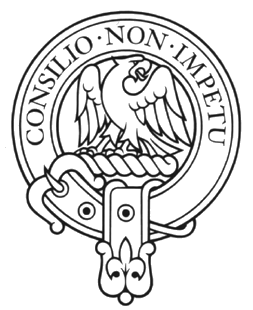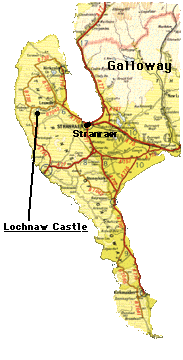
|
Agnews on the Net Clan Agnew Discussion Area Clan Agnew Contacts |

|
Agnews on the Net Clan Agnew Discussion Area Clan Agnew Contacts |

The first asserts that the name is of Norman ancestry from the Barony d'Agneaux. This origin has the family moving from Normandy to England then on to Ulster then finally to Scotland.
The second possible origin of the name is a Celtic one through the native Ulster sept of O'Gnimh (pronounced O'New). The O'Gnimh were the hereditary Bards to the great O'Neils of Clan Aodha Bhuidhe in Antrim. The name went through many transformations, O'Gnive, O'Gnyw, MacGnive, finally being anglicized to Agnew. This would give the Agnews a common descent with other great names such as MacDonald and MacDougall through Somerled, the twelfth century King of the Isles. The Agnew eagle crest may also echo the similar device which appears on the shield of the descendants of Somerled.
 By the 1300's the Agnews where the hereditary Lords of Larne in Ulster and it is from them that the Scottish branch descends. In 1375 the Lords of Northern Ireland were anxious to rid themselves of the English yoke and so invited Edward Bruce, younger brother of King Robert the Bruce of Scotland, to come to Ulster to be their King. The Agnew Lord of Larne played a prominent role in this endeavour and fought by Edward's side for the three years of his uneasy rule of Ireland.
By the 1300's the Agnews where the hereditary Lords of Larne in Ulster and it is from them that the Scottish branch descends. In 1375 the Lords of Northern Ireland were anxious to rid themselves of the English yoke and so invited Edward Bruce, younger brother of King Robert the Bruce of Scotland, to come to Ulster to be their King. The Agnew Lord of Larne played a prominent role in this endeavour and fought by Edward's side for the three years of his uneasy rule of Ireland.
When, in 1318, Edward Bruce lost his Kingdom and his life on Faughard Hill, the Irish Lords retreated, under the Earl of Moray, to Scotland. Many warm friendships had been formed between those who had fought side-by-side for three years and it is natural that the Irish Lords turned to the Scottish court for the advancement that they could not hope for at home.
Among these friendships was one between the son of the Lord of Larne and Alexander, the son of Edward Bruce. On his return to Scotland, Alexander Bruce was appointed Lord of Galloway and had the keeping of the castles of Lochnaw and Wigtown. It is not surprising that young Agnew should cross the Channel to visit his friend, thus established in the Rhinns of Galloway, within sight of the Irish shore; nor was his visit unwelcome, as we find it stated in Sir George MacKenzie's MSS;
"In the reign of King David 2nd a son of ye Lord of Lairn (alias Lord Agnew) gott keeping of the King's Castell of Lochnaw and was made heretable Constable y.rof"Having shown "bravery and spirit" in this office, Agnew was shortly after appointed Sheriff of Wigtoun, the sheriffship to be a hereditary gift.
To hold the King's commision among the wild Scots of Galloway in the fourteenth century was no sinecure, and doubtless required both "bravery and spirit".
The sheriff's son, Andrew Agnew, married the daughter of the chief of the MacDowalls, and it was from his second son, William, that the Lochryan branch of the family descended.
Andrew Agnew of Lochnaw was killed in the Battle of Pinkie Cleugh in 1547. Sir Patrick was MP for Wigtounshire from 1628 to 1633 and from 1643 to 1647. He was created a Baronet of Nova Scotia on the 28th of July 1629. His son, Andrew was also an MP for Wigtounshire and was knighted and created Sheriff of Kirkcudbright as well as of Wigtoun. He married Anne Stewart, daughter of the first Earl of Galloway.
Sir Andrew, the fifth Baronet was a distinguished soldier who commanded the 21st Foot, later the Scots Fusiliers at the Battle of Dettingen in June 1743. King George II is said to have remarked that Sir Andrew's regiment had let French cavalry in among them to which Sir Andrew replied:
"Yes, please your Majesty, but they didna win back again."The castle and lands of the Agnews have since passed from the family, but the worldwide family of Agnew has developed strong links with their Scottish homeland, largely through the efforts of the present chief, Sir Crispin Agnew of Lochnaw, eleventh Baronet. After a career in the regular army, he was called to the Scottish Bar and is now a distinguished advocate. He is one of Scotland's leading heraldic experts and Rothesay Herald at the Court of the Lord Lyon. A thriving Clan society exists in Scotland as well as branches in the United States and Canada.






